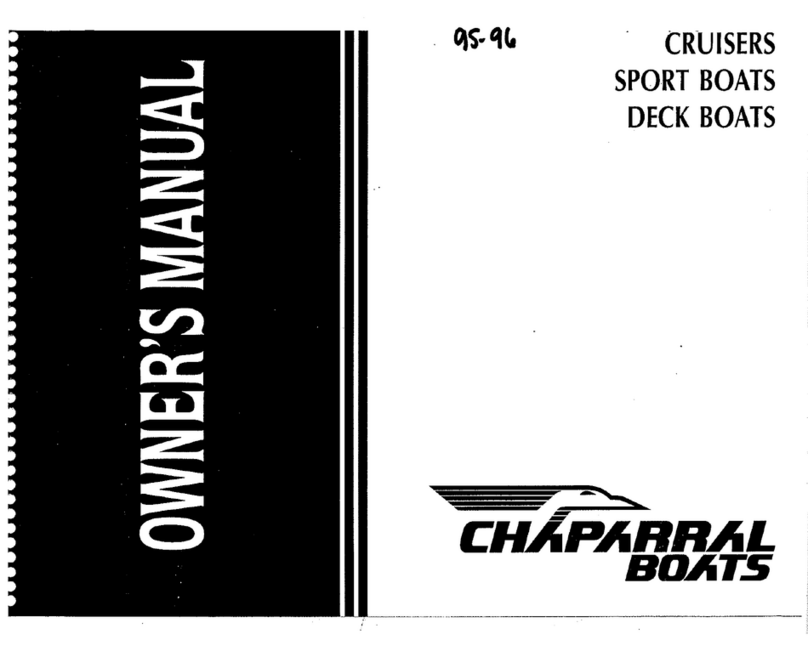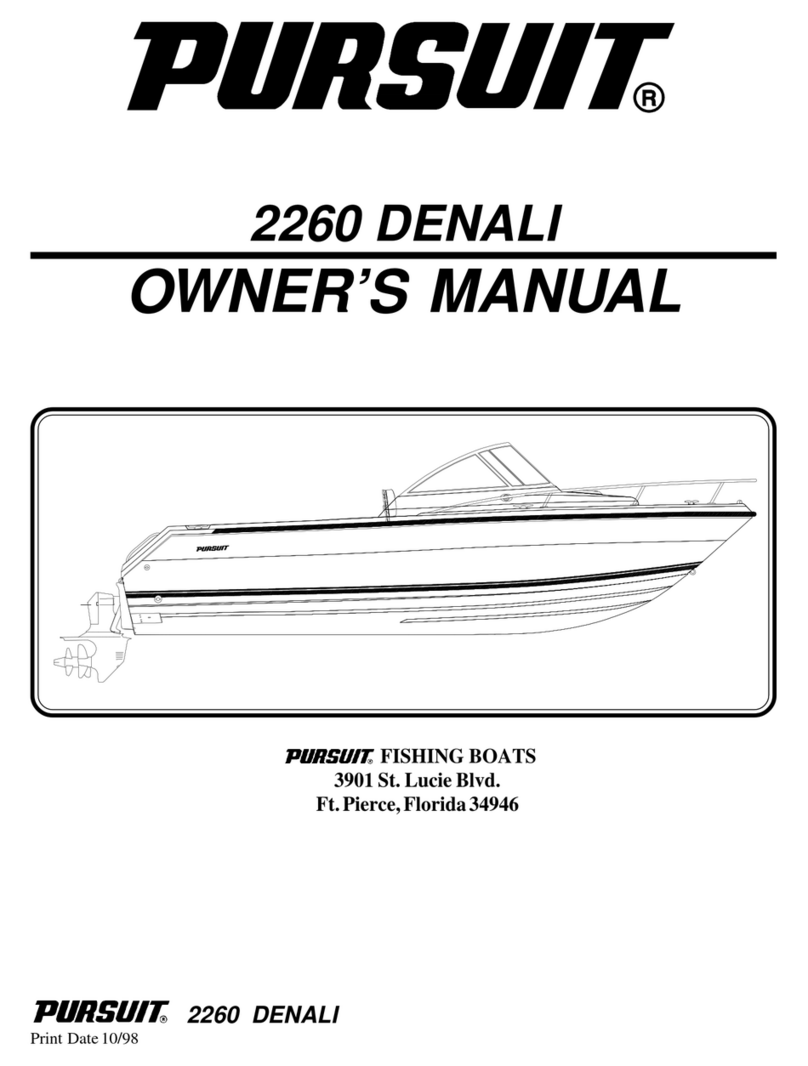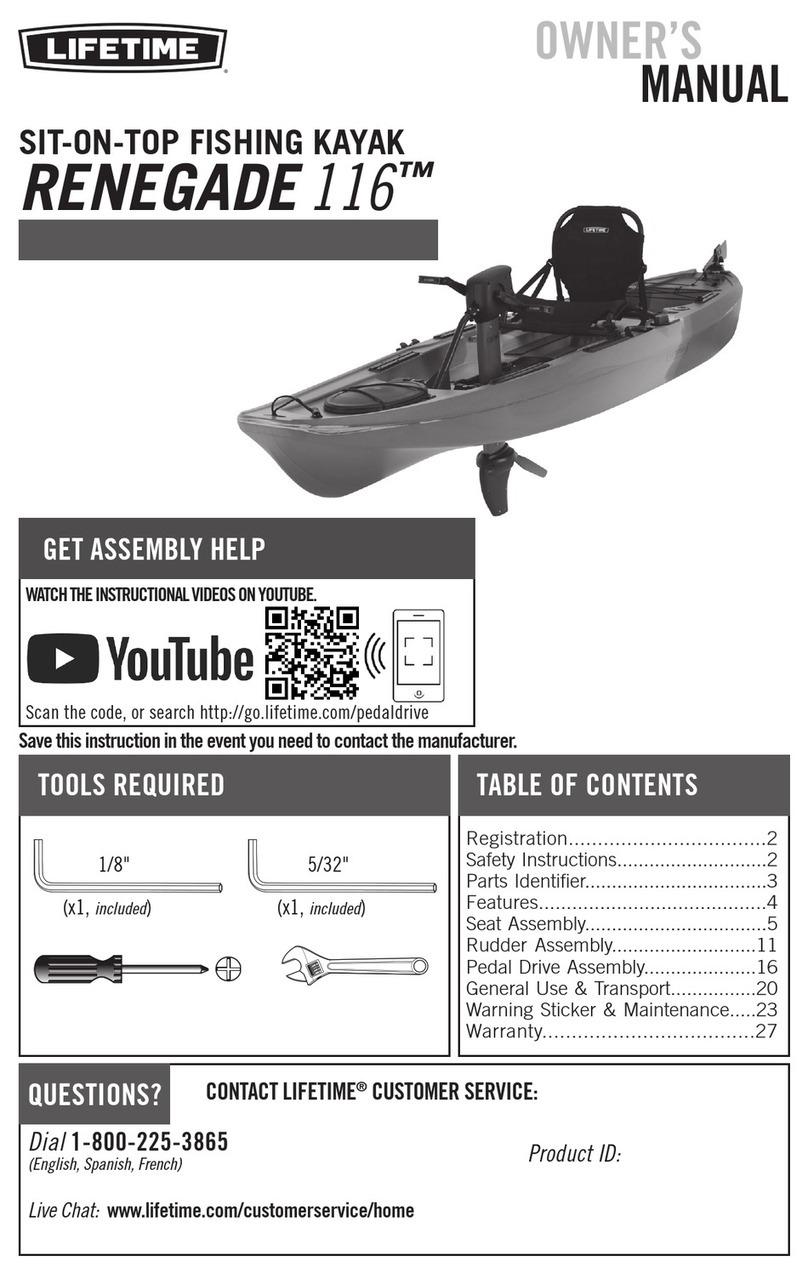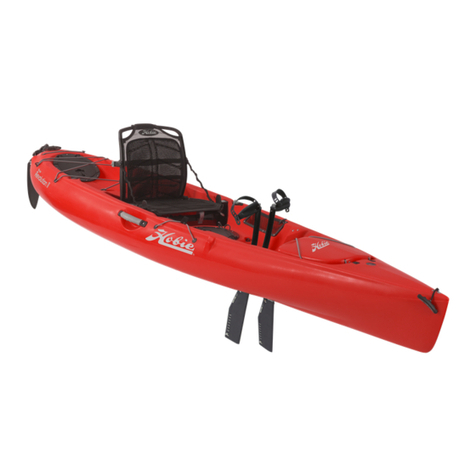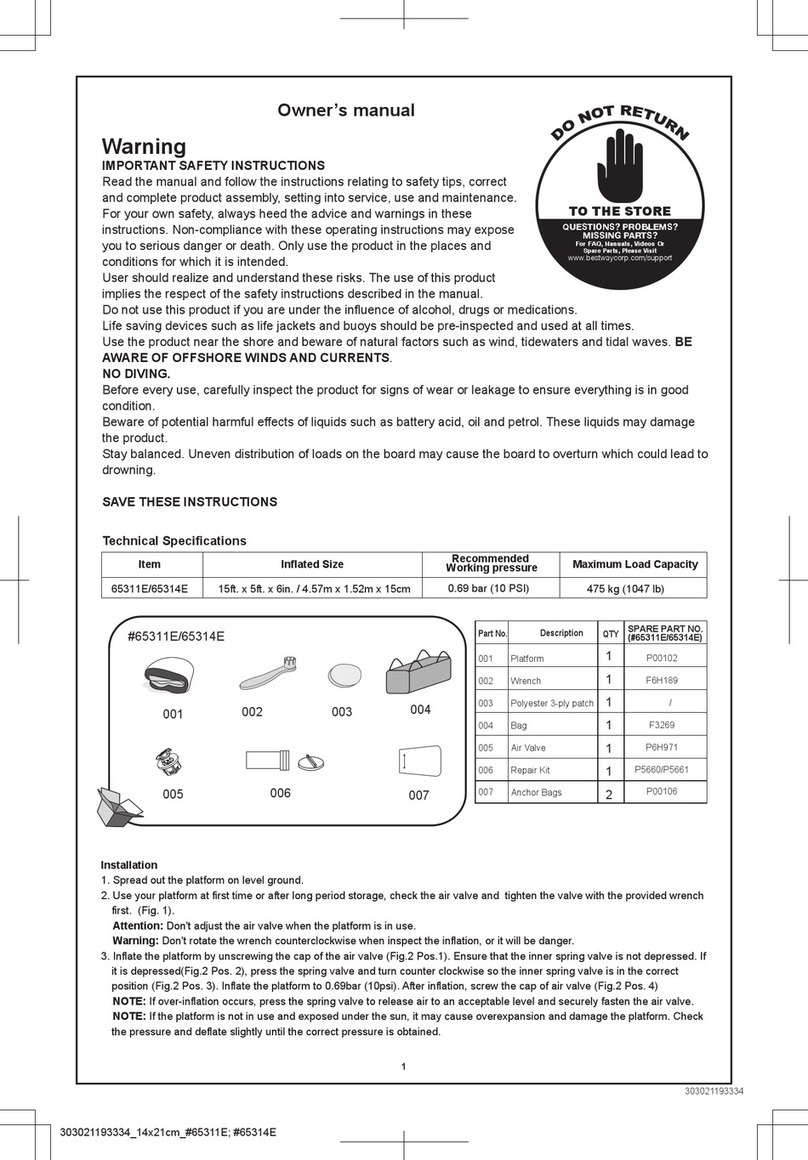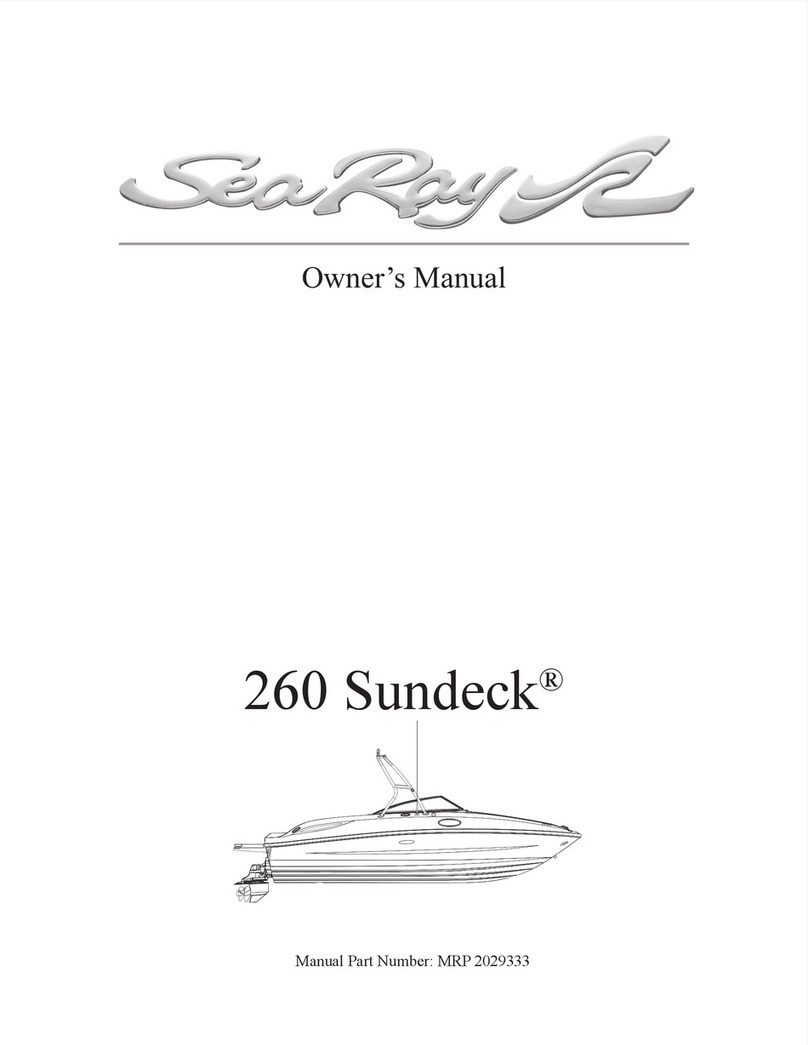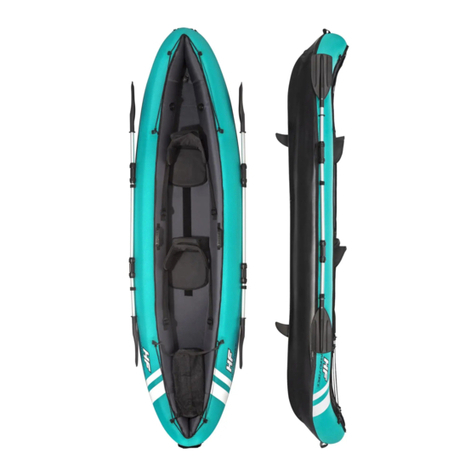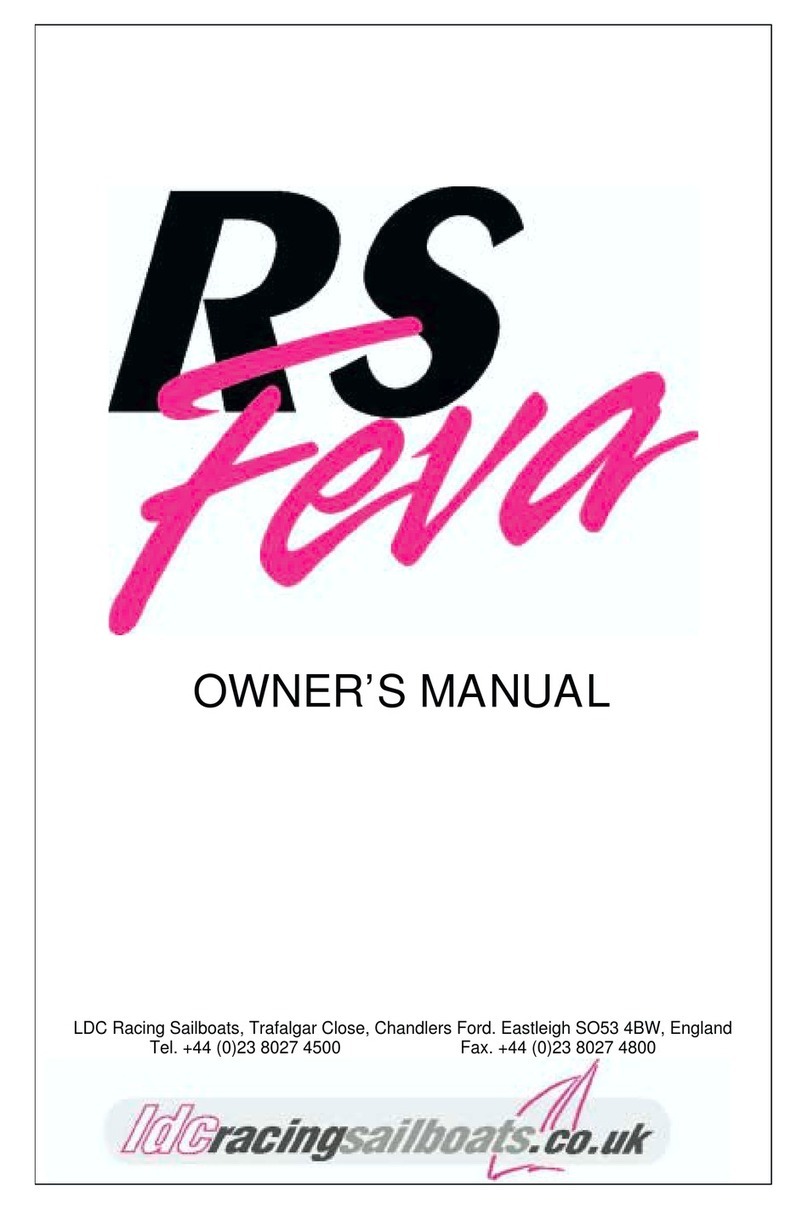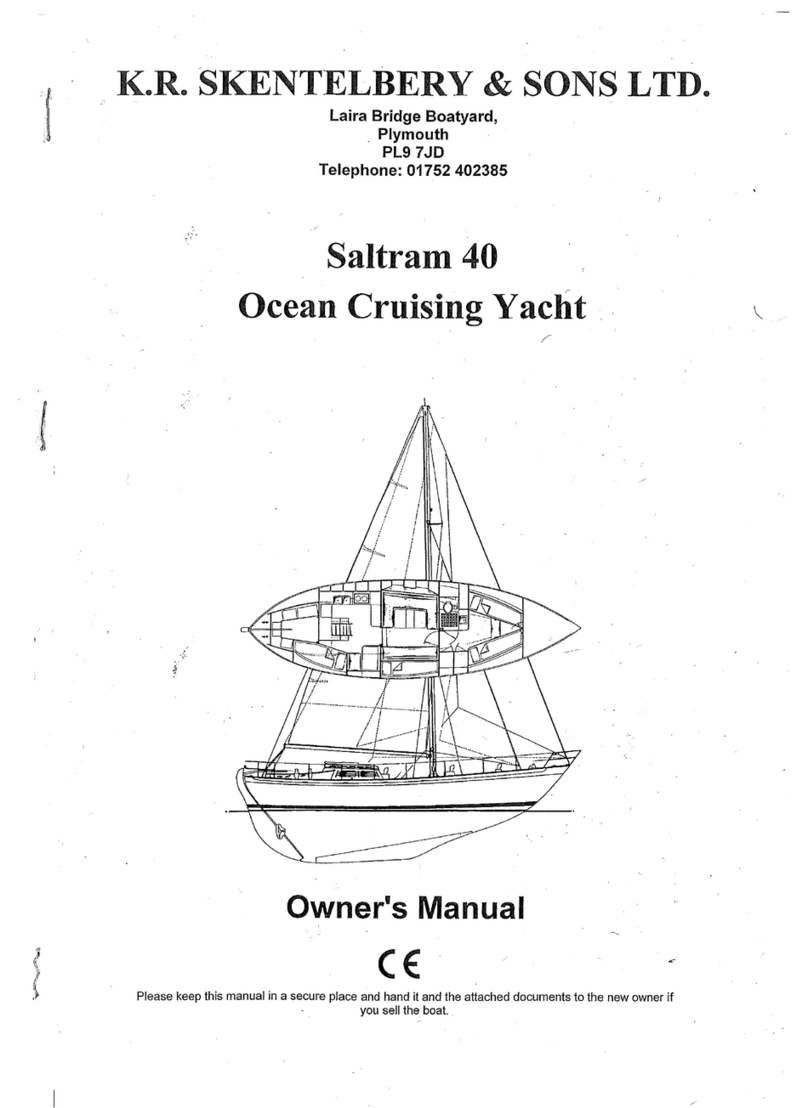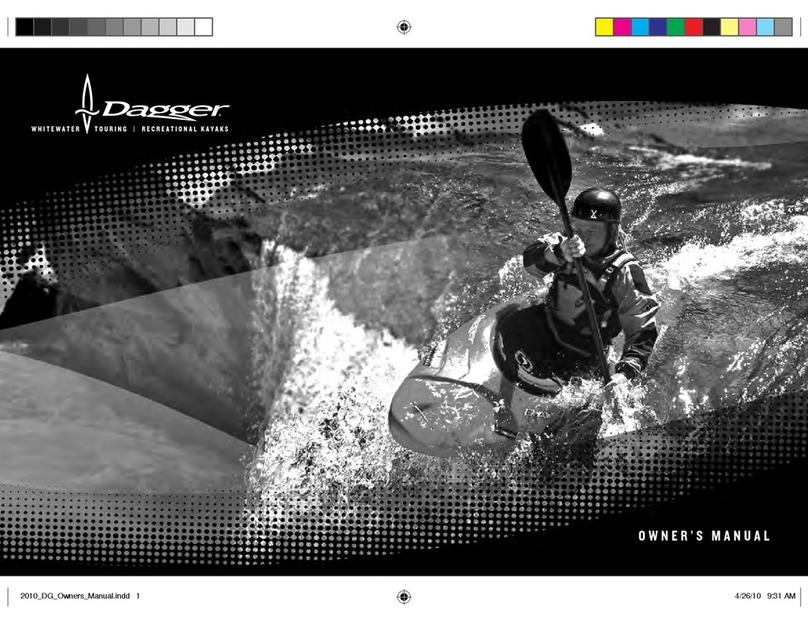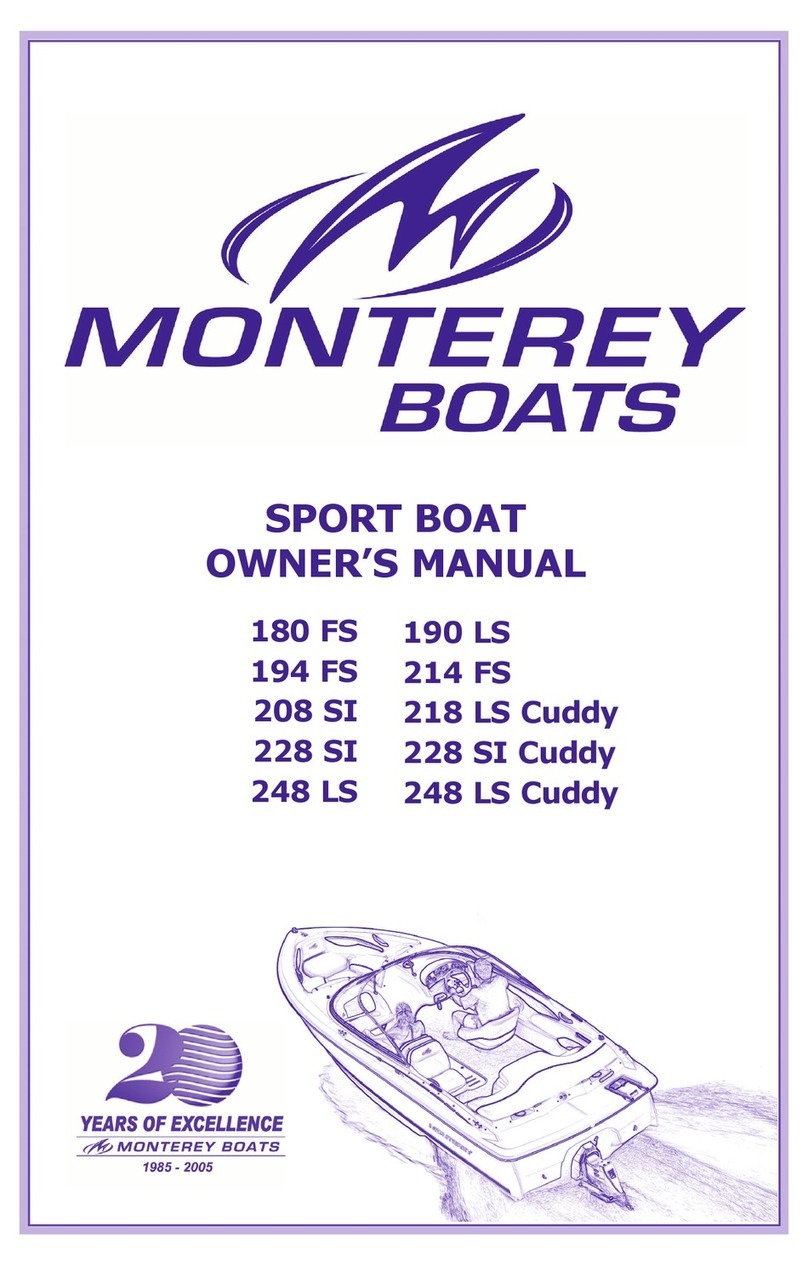forest river Marine User manual

www.forestriverinc.com
Begin the Journey!
BEGIN THE JOURNEY!
Marine
Owner’s Manual
© 2014 Forest River, Inc., a Berkshire Hathaway company. 09/14
Forest River Interactive Mobile Manuals
Download your Forest River mobile app or visit our dynamic online manual to
enhance your ownership experience. These interactive options provide incredible
ease and insight into use, maintenance and enjoyment of your Forest River product.
Ranging from “How-To” videos, pictures and illustrations of various components,
systems and features to fully searchable content and downloadable PDFs for
individual component owner’s manuals, answers are always just a click away.
Visit www.forestriverinc.com/manuals or scan
the QR Code to access even more information on your
Forest River product. Never be without your manual again!
OwnersManualCovers.indd 19-20 8/20/2014 8:32:42 AM

Welcome Letter
Welcome Home!
Thank you for selecting a Forest River Marine boat, and welcome to the lifestyle that gives you the freedom to enjoy
boating fun whenever you wish.
Your Forest River Marine boat complies with the requirements set forth by the National Marine Manufacturers Associa-
tion (NMMA) as well as various other federal and state agencies.
Items of quality, such as this Forest River Marine boat, respond best to considerate treatment and care. Therefore,
before using it, we suggest that you review the entire contents of this manual. The material within has been prepared
in sufficient detail to be of maximum assistance, and the illustrations will be of considerable help when you are getting
to know your new boat.
Review this manual with your dealer. They should be able to answer any questions you may have. Read all the litera-
ture supplied with your new Forest River Marine boat, including all warranty and warranty registration information.
Remember to validate the warranties by completing and mailing the individual warranty cards for each of the respec-
tive manufacturers.
Be sure your dealer has completed and returned your Forest River Marine Warranty Registration Form.
Your Forest River Marine boat underwent a thorough inspection before it was shipped to the dealer. However, to ensure
your complete satisfaction, the dealer will perform an inspection of various components and the operating system of
your boat before you take delivery. Take time to walk through this inspection with your dealer. A walk-around with your
dealer will help you become more familiar with your new Forest River Marine boat and its components while providing
you with the assurance that everything is in proper working order.
Should a problem develop for which you need assistance, contact your Forest River Marine dealer.
Some products described or displayed in this manual may be optional equipment, and not included with your boat. Any
special equipment, modifications, or additions made by, or at the request of, the customer, or any subsequent owner,
whether made at the factory or in the field, are not covered in this manual. We reserve the right to change the construc-
tion, or material, of any part, at any time, without incurring the obligation to install such changes on previously manu-
factured Marine boats.
This Owner’s Manual was current at the time of printing however, products are continually being upgraded and
improved; therefore, some differences may occur between the description in this manual and the product/s in your boat.
If differences do occur, follow the component manufacturer’s instructions provided with your Forest River inc. Marine
customers’ literature packet.
We wish you many happy and adventurous days as you make great memories with your new Forest River Marine boat.
1

FOREWORD ................................1
Welcome Letter ..........................1
INTRODUCTION .............................3
Dealer’s Responsibilities ....................3
Customer’s Responsibilities ..................3
Customer’s Packet ........................4
Manufacturers’ Warranties ...................4
State Registration .........................4
Insurance ...............................4
Disposal of Garbage .......................4
Marine Sanitary Device .....................4
SAFETY ...................................5
Basic Safe Boating Recommendations .........5
Safety Gear and Equipment .................5
Safe Boating Practices .....................6
Safe Operation ...........................6
Basic Safe Boating Figure ...................7
Dangers, Warnings, and Cautions .............7
Carbon Monoxide .........................8
Drugs and Alcohol ........................8
Fuel System Safety ........................8
Lanyard Stop Switch .......................8
Hazardous Conditions ......................9
Water-Swimming Safety ....................9
Water-Skiing Safety .......................10
CARING FOR YOUR PONTOON BOAT ............11
Engine ................................11
Aluminum Surfaces .......................11
Electrical System Care ....................11
Floor Coverings .........................12
Livewell System Care .....................12
Furniture ...............................12
Canvas ................................13
Exterior Graphic Care .....................14
Storage ...............................14
UNDERWAY WITH YOUR PONTOON BOAT ........15
Boater’s Checklist ........................15
Launching Your Boat ......................15
Reloading Your Boat ......................15
Fueling Your Boat ........................16
Loading Passengers and Gear ..............16
Boarding Your Boat .......................16
Boat Weight Distribution ...................16
Storage Areas ...........................17
Steering Your Boat .......................17
Boat Speed ............................17
General Navigation Rules ..................17
Docking ...............................18
Trimming ..............................18
TRAILERING YOUR PONTOON BOAT .............19
Boat Trailer Laws ........................19
Capacity Data ...........................19
Tongue Weight ..........................19
Hitch .................................19
Chains ................................19
Backing a Trailer .........................19
Launching Recommendations ...............19
Loading Your Boat Back on the Trailer .........19
PONTOON BOAT COMPONENTS AND SYSTEMS .....20
Electrical Wiring Systems ..................20
Instruments .............................21
Digital Depth/Fish Finder Graph ..............24
12 Volt Plug ............................24
Stereo System ..........................24
Lights .................................25
Controls ...............................25
Livewell System .........................27
Fresh Water System ......................27
Bimini Top Canvas .......................27
Trolling Motor ...........................27
Fuel System ............................28
Boarding Ladders ........................29
Privacy Enclosures .......................29
Fishing Seats ...........................29
Tables ................................29
Cupholders .............................30
PONTOON BOAT PERFORMANCE ...............31
Performance Factors ......................31
Ventilation ..............................31
INDEX ...................................32
TABLE OF CONTENTS
2

Dealer’s Responsibilities
1. The selling dealership is responsible for inspecting
both factory and dealer installed components for
proper operation. This is known as the pre-delivery
inspection and systems check.
2. Your dealer is required to provide a thorough and
complete walk-through demonstration. This demon-
stration should provide a good understanding of
how your new boat operates.
3. The customer’s information packet should be pre-
sented at this time. This information should include
all warranty cards, component information, compo-
nent operation, and maintenance instructions relat-
ing to your new unit.
4. All component warranty forms should be discussed
and/or completed at this time. Your selling dealer
should assist you in understanding any and all lim-
ited warranty provisions to help you avoid loss of
warranty for any reason. Ask any questions you
may have before leaving the dealership.
5. Your dealer should provide you with information
concerning any need for service for your unit,
whether in or out of their area. They should provide
contact numbers for the dealership both during and
after hours along with contact information for the
correct Forest River Marine division.
Customer’s Responsibilities
1. Operate all equipment in accordance with the
manufacturers’ instructions.
2. Familiarize yourself with your boat. Observe all the
component manufacturers’ instructions regarding
the use and service of their products.
3. Familiarize yourself with and obey all warning labels
on your boat.
4. Properly complete all regular and maintenance. As
the owner, you have the responsibility to properly
maintain your boat. Be sure you have service per-
formed in a timely manner don’t ignore a problem.
It isn’t always necessary to take your unit to a ser-
vice center; sometimes a phone call is all that is
needed. The service technicians can advise you.
5. Complete and send in all the warranty cards. Doing
so may help you avoid conditions arising from
neglect that are not covered under warranty.
6. Be a safe boater. Forest River Marine Inc. recom-
mends that all boaters take boating safety courses
and always provide children with adult supervision.
7. Always obey all applicable federal, state, and local
laws.
8. Insure your boat with a reputable company.
Forest River Marine Inc. has a permanent record of your
boat, which is retained under its “Hull Identification Num-
ber” (HIN). Data regarding equipment and accessories,
as well as dealer/shipping information, is documented.
When contacting your dealer concerning warranties or
service, please have all relevant information such as
serial number (HIN), model, and boat color available.
The “Hull Identification Number” (HIN) is located on the
starboard rear corner of the boat. Failure to include the
HIN may create delays in service from your dealer.
The best way for you to obtain warranty or repair service
is to work with the Forest River Marine dealership where
you purchased your boat. Forest River Marine dealers
are equipped to handle any concerns you may have after
the sale of your new boat.
NOTE:
Modifications to your boat, without written authorization
from Forest River Marine Inc., could result in reduction or
loss of warranty coverage. Contact your Forest River
Marine dealer before making such changes.
The following is a list of suggestions to assist you in
avoiding most warranty issues:
1. Read your warranties and review them with your
selling dealer. The dealer’s obligation is to educate
you regarding the proper and safe operation of your
boat and all its components.
2. Be sure to inspect the entire unit and note any ser-
vice issues.
3. Locate all paperwork and ask any questions you
may have before leaving the dealership.
NOTE:
Forest River Marine Inc. wants you to have the best pos-
sible adventure with your new boat, which requires that
you fully understand how your new boat operates.
Please address immediately any questions or concerns
you may have regarding your boat with your dealer
before using your boat for the first time.
INTRODUCTION
3

Customer’s Packet
Your Forest River Marine boat has many features and
accessories that have existing printed material provided
by the various equipment manufacturers. This informa-
tion is compiled in a package that we reference through-
out this manual as a “Customer’s packet”.
This customer’s packet includes a Forest River Marine
Owner’s Manual, component manuals, and engine
manual (if applicable) to advise on operation, service,
specifications, maintenance, warranty and other useful
facts. Your Customer’s packet can also be used to retain
instructions and data compiled on additional equipment
and accessories installed after delivery. Also, please
read the included NMMA manual, “Pontoon/Deck Style
Boats”.
Manufacturers’ Warranties
The following list of components has been compiled to
help you know which products installed on your boat may
have their own warranties.
If you have any of these components on your boat, be
sure to check the manufacturer’s literature supplied with
your Forest River Customer’s packet to confirm whether
they require you to register your purchase with them to
validate their warranty.
These warranties usually apply only to the first owner of
the boat. We recommend that you send the various war-
ranty registration cards immediately before any time con-
straints on registration expire.
Manufacturer’s literature is supplied by each individual
company according to the specific items used in the pro-
duction of your boat. This information is part of the Cus-
tomer’s packet you received with your boat.
Only those products which are used on your unit will be
included in this packet. Inspect this literature with your
dealer during the pre-delivery inspection and report any
literature shortage to the dealer at that time. Below is an
example of the types of information you will find.
APPLIANCES WATER
•Refrigerator
•Water Resistant
Stereo with Mp3 &
iPod Compatibility
•GPS
•Water Pump
•Faucet
ELECTRICAL MISCELLANEOUS
•Battery •Fire Extinguisher
NOTE:
A component manufacturer is one who produces a prod-
uct which is used in the production of your Pontoon boat.
State Registration
All motorized watercraft not documented by the U.S.
Coast Guard must display registration numbers. Every
boat equipped with propulsion machinery of any type
must be registered in the main state of usage. In nearly
all states, this means registration with the designated
state agency. In a few jurisdictions, the Coast Guard
retains registration authority. Registration numbers and
validation stickers must be displayed on the boat accord-
ing to regulations.
Insurance
The boat owner is legally responsible for any damages or
injuries caused by the boat. In most states this is true
even if someone else is operating the boat when the
accident occurs. You should carry adequate personal
liability and property damage insurance on your boat as
you do on your home and automobile. You should also
protect your investment by insuring your boat, motor, and
trailer against physical damage or theft. Please contact a
qualified insurance professional to help you.
Disposal of Garbage
Plastic refuse dumped in water can kill fish and marine
wildlife and can damage propellers and water intakes.
Other forms of waterborne garbage can litter beaches
and cause infection and illness. U.S. Coast Guard regu-
lations completely prohibit the dumping of plastic refuse
or other garbage mixed with plastic anywhere and
restrict the dumping of other forms of trash within speci-
fied distances from shore. Do not litter.
Marine Sanitary Device
You are responsible for obeying all local laws concerning
waste discharge. If your boat has a portable toilet, con-
tact the U.S. Coast Guard, local marina, or your dealer
for information concerning these laws.
INTRODUCTION
4

Forest River Marine is very concerned about the safety
of all boat owners and their families. That is why Forest
River Marine is committed to building the safest boats in
the industry.
You should become fully familiar with the operating pro-
cedures and safety precautions in this manual and the
other information in the Customer’s packet before you
use your boat. Remember, it is the owner’s responsibility
to be a safe boater, to follow and enforce safety guide-
lines, and to use common sense to make safe boating a
priority.
Before using your boat, be sure all U.S. Coast Guard
required safety equipment is on board. This includes the
minimum required equipment and additional gear
needed for your outing. Please be aware that if you oper-
ate in foreign waters (such as Canada or Mexico) you
must meet the requirements for safety equipment for
those countries.
Periodically inspect all safety equipment to be certain it is
in proper operating condition. Make sure all passengers
know what safety equipment is on board, where it is, and
how to use it. Also, you should understand (but are not
limited to) the following basic safe boating
recommendations.
Basic Safe Boating
Recommendations
Boating safety and the safety of your passengers are
your responsibilities. You should fully understand all of
the following safety precautions before you use your
boat. Please take safe boating seriously for the safety of
yourself, your family and other water users.
Never operate a boat while under the influence of drugs
or alcohol. Doing this is a federal offense. Make sure
only qualified drivers operate your boat.
Keep your boat and equipment in safe condition. Inspect
the boat, engine, safety equipment, and all boating gear
regularly.
Be sure lifesaving and fire-extinguishing equipment are
on board. This equipment must meet regulation stan-
dards, and it should be noticeable, accessible, and in
safe working condition. Your passengers should know
where this equipment is and how to use it. Supervise
children at all times.
Before you leave shore, tell a responsible person ashore
where you are going and when you expect to return.
Do not allow passengers to sit on the bow, transom, rail,
sun deck pad, furniture backrest, or swivel fishing seat
while your boat is moving
Do not overload or improperly load your boat. The capac-
ity plate is a guide for load limits. The capacity of your
boat is reduced by turbulent water and other adverse
weather conditions. Check water and weather conditions
before leaving shore. Use common sense and good
judgment when loading your boat.
Instruct at least one passenger on the fundamentals of
basic and safe operation in the event of an emergency.
DANGER
Never allow swimmers/skiers to enter or exit the
boat with the engine running or the propeller mov-
ing.
Obtain information and a nautical chart for new areas
when possible.
NOTE:
Read, understand, and follow all warning labels on your
boat.
Never allow individuals under the age of 16 to operate
your boat. Inexperienced drivers, passengers, and all
children should have constant and direct adult
supervision.
Safety Gear and Equipment
•Personal Flotation Devices (PFD)
NOTE:
Some states may restrict the use of certain types of
PFDs
•Fire Extinguisher
•Visual Distress Signal
•Navigation Lights
•Horn
•Throwable Life Buoy
Please note that children and non-swimmers are advised
to wear Personal Flotation Devices at all times.
Contact the U.S. Coast Guard for complete details per-
taining to required safety gear and equipment.
SAFETY
5

In addition to the “required safety equipment”, there are
additional items that will provide an extra margin of
safety and comfort for you and your passengers. You
should consider adding some or all of the following gear
based upon your boating needs:
•Auxiliary propulsion (oar/paddle)
•Boat hook
•Compass
•Dock fenders
•Extra clothing
•First aid kit
•Flashlight
•Foul weather gear
•Ground tackle (anchor and anchor line)
•Nautical charts of the boating area
•Ring life buoy
•Signal flares (handheld and/or aerial)
•Sunscreen lotion
•Tow line
•VHF marine radio (dash unit or handheld)
Safe Boating Practices
As the Skipper of your vessel, YOU are responsible for
your own safety, the safety of your passengers, and the
safety of fellow boaters. Alcohol and/or drug consump-
tion and boating DO NOT mix. Operating under the influ-
ence of drungs and/or alcohol endangers the lives of
your passengers and other water users. Federal laws
prohibit operating a boat under the influence of alcohol or
drugs.
Safe Operation
Safe operation means that you do not misuse your boat
nor do you allow your passengers to do so. Safe opera-
tion means using good judgment at all times. It includes
these actions:
Be sure at least one other passenger is familiar with the
operation and safety aspects of the boat in case of emer-
gency. Do not operate a boat alone!
Do not exceed the maximum power rating stated on the
certification plate attached to your boat.
Do not use your boat in weather or sea conditions
beyond the skill and experience of the operator or the
capability of the boat.
Load your boat within the limits listed on the capacity
plate. Balance loads bow to stern and port to starboard.
Maintain boat speed at or below the local legal limit.
Avoid excessive speed or speeds not appropriate for
operation conditions.
Make sure the passengers and gear do not obstruct the
driver’s view or ability to move.
Provide a Personal Flotation Device (PFD) for each boat
passenger.
DANGER
•Do not smoke while fueling your boat.
•Do not allow passengers to sit on the foredeck
or sun deck while the boat is underway. This
will prevent falls overboard and possible
injury or death by the rotating propeller.
•Make sure the engine is off and the propeller
is completely stopped before using boarding
ladders.
•Always keep all gates closed while the boat is
in motion to prevent falls overboard and pos-
sible injury or even death by a rotating propel-
ler!
SAFETY
6

Basic Safe Boating Figure
NOTE:
This Basic Safe Boating Figure is intended to be used as a general guideline only. It does not exclude any other safety
recommendations, laws, or procedures required by you as the owner of your boat. While your boat’s floor plan may
be different from the model shown, the same safety precautions apply.
Dangers, Warnings, and Cautions
You may see various symbols in this manual. They have
the following meanings:
DANGER
DANGER- Cases that might cause death, injury or
considerable property damage if the danger is dis-
regarded.
WARNING
WARNING- Cases that could potentially cause
death, injury or considerable property damage if
the warning is disregarded.
CAUTION
CAUTION- Cases of unsafe routines or hazards
that could cause lesser injury or property damage
if disregarded.
Do not ride on sun deck
while underway.
Do not sit on rails or top of
furniture while underway.
Do not use boarding ladder
when the engine is running.
Do not sit on dec
k
while underway.
SAFETY
7

Carbon Monoxide
Exhaust fumes contain carbon monoxide (CO), an odor-
less and colorless gas. Carbon monoxide is poisonous
and a health hazard that can be fatal if breathed over an
extended period of time. Some of the symptoms of CO
poisoning include: dizziness, nausea, headache, sleepi-
ness, vomiting, throbbing in temples, muscular twitching
and the inability to think clearly. If CO poisoning is sus-
pected, take down any canvas enclosures immediately,
and seek urgent medical attention if these symptoms
persist.
Carbon monoxide can accumulate in enclosed areas and
under canvas.
DANGER
•Carbon monoxide can be harmful or fatal in
inhaled. Keep exhaust outlets clear of block-
age. Provide adequate ventilation. Open win-
dows and vents to ensure good ventilation.
•Carbon monoxide in engine exhaust from
your boat can accumulate within enclosed
areas when your boat is operating at a slow
speed or stopped in the water. Installing rear
canvas while underway increases the risk of
carbon monoxide accumulation in your boat.
Wind blowing in from the stern of your boat
can increase accumulation. Provide adequate
ventilation or increase speed as needed.
DANGER
Carbon monoxide can be harmful or even fatal if
inhaled. Keep exhaust outlets clear of blockage.
Provide adequate ventilation. Open windows to
ensure good ventilation.
Drugs and Alcohol
DANGER
Never operate a boat under the influence of drugs
and/or alcohol.
The use of alcohol and/or drugs affects everyone in at
least four possible ways that affect safe boat driving
skills: judgment, coordination, reaction time, and vision.
Also, the influence of drugs and alcohol by passengers
can be dangerous. Under the influence, passengers can
fall overboard and risk injury and death.
Fuel System Safety
DANGER
•Use and handle fuel with the utmost care.
Gasoline is highly flammable and can cause
personal injury or death.
•Do not smoke while fueling your boat. Shut off
the engine while fueling your boat.
•Gasoline vapors are highly explosive. To pre-
vent a possible explosion and fire, check for
fumes or accumulation of fuel before each
engine start.
WARNING
•Leaking fuel is a fire and explosion hazard.
Inspect system regularly. Examine fuel system
for leaks or corrosion at least annually. Use a
marine service center if needed to do this
inspection.
•Do not remove the anti-siphon valve. This
device helps to deter fire and explosions.
Lanyard Stop Switch
This safety device automati-
cally stops the engine when
the RED lanyard is attached
to the operator and the
operator falls or moves
away from the helm station.
The stop switch incorpo-
rates a shutoff switch,
switch clip, lanyard, and lan-
yard clip. This clip is
securely attached to the
driver’s clothing, arm, or
leg. Be sure to attach this
lanyard to the driver during
boat operations.
NOTE:
The switch on your boat may be different from the switch
shown here. Refer to the engine owner’s manual for spe-
cific information.
DANGER
The lanyard stop switch must never be removed or
modified and must always be kept free from
obstructions that could interfere with its operation.
The driver should ALWAYS attach this device while
the engine is running!
SAFETY
8

Hazardous Conditions
All waters have different characteristics that could pres-
ent dangers to you and your boat. Underwater hazards,
such as tree stumps, sand bars or shallow waters, are to
be avoided. If you are unfamiliar with the waters, ques-
tion other boaters or obtain nautical charts of the waters.
If you are uncertain of water depths, move slowly through
the water!
Forest River Marine cannot be responsible for damage
or personal injury that occurs while using your boat dur-
ing hazardous boating conditions. Forest River Marine
cannot be responsible for damage resulting from tree
stumps, sand bars, shallow waters, wave swells and the
like.
When hazardous weather conditions exist, postpone
your boat outing. Check the latest weather reports for
local water conditions. When out on the water, periodic
weather checks are recommended.
DANGER
Pontoon boats are designed for boating on inland
waterways, rivers, lakes and bays. Open sea and
oceanic pontoon boat voyages should be avoided
by all pontoon boat owners and operators. Any
such use can place boat occupants in serious dan-
ger and can cause physical damage to your boat.
Open seas can be very dangerous. Swells and
high waves can cause damage to your pontoon,
cause a driver to loose control of the boat, and/or
put passengers in serious danger. Waves coming
over the bow of the boat are very dangerous and
can dent and damage the fence/rails.
WARNING
If you should damage your boat due to any hazard-
ous conditions, take your boat to a qualified
marine service center for inspection and repair. Do
not continue to use your boat if it is damaged.
Water-Swimming Safety
Swimming can always be hazardous unless safety rules
are observed.
When swimming from a boat, please follow these basic
safe swimming recommendations:
•Anchor the boat and shut off the motor.
•Swim on the shore side of the boat away from other
boat traffic.
•Be sure someone is in the boat at all times looking
out for those swimming.
•Never swim alone.
DANGER
•Never dive from any part of a boat. Diving
from the boat may result in personal injury or
death.
•Never enter the water while the engine is run-
ning or the propeller is turning.
SAFETY
9

Water-Skiing Safety
Skiing safety requires the following basic rules. You are
required to understand and follow these rules concerning
water skiing safety:
•Make sure the engine is off and the propeller has
stopped turning before the skier(s) gets into the
water.
•Only when the skier(s) is at a safe distance from the
boat should you start the engine.
•Move the boat slowly forward until the slack is out of
the tow rope.
•Be sure there is no traffic ahead and then apply
enough throttle to get the skier up.
•When the skier is up and the way is clear, follow his
signals to attain a speed the skier is comfortable
with.
•When a skier goes down, watch for the signal that
he is OK.
•Always approach the skier on the starboard (right)
side and stop the motor when close to the skier.
•Always be aware of shallow water and obstructions
in the water.
•Do not ski after dark. This is illegal in most states
and is not safe.
•Some states may require a mirror on the boat.
•Always have someone watch the skier to inform the
boat driver of the skier’s constant condition.
•Do not ski near swimmers or in crowded boat traffic
•Keep away from fishermen.
DANGER
DO NOT use the boarding ladder and swim plat-
form when the engine is running. Transom door (if
equipped) must be closed and locked in place. Do
not enter the water while the engine is running.
WARNING
Always use a boarding ladder to enter or exit a
boat. Do not use pontoon tubes for entering or
leaving the water. Get assistance if needed by a
passenger on board.
For specific information, please contact:
American Water Skiing Association
P.O. Box 191
Winter Haven, FL 33880
Always have someone on board other than the driver to
watch the skier.
WARNING
•Keep a downed skier in sight constantly.
•Your boat is not designed for and should not
be used for pulling parasails, kites, gliders, or
any device which can become airborne.
•Never back up to anyone in the water.
SAFETY
10

Proper care helps ensure that your boat will continue to
look like new after years of service. We recommend that
maintenance and repairs be performed by your Forest
River Marine dealer or a marine service center. However,
some boat owners may prefer to take care of routine
maintenance and repairs themselves. For those owners,
this section includes general information and basic pro-
cedures. For additional information, read the engine and
other component manuals included in your Customer’s
packet.
When your boat is not in use, protect it from the harsh
elements by storing it inside or under a roof with a moor-
ing cover or playpen cover installed. Do not dock or store
your boat under trees. Dirt, leaves and other debris will
accumulate on the boat and can damage carpet and fur-
niture vinyl surfaces. Please check with your dealer
before beginning any maintenance or repair if you are
not sure about the proper tools and supplies that are
recommended. Also, always refer to the manufacturers’
manuals for detailed maintenance and repair proce-
dures. If any information conflicts with information stated
in the manufacturers’ manuals, those manuals must take
precedence. Also, some information in this section may
not pertain to all Forest River Marine products, and some
items may be optional equipment.
Engine
Refer to the engine owner’s manual for recommended
information about engine care and maintenance. If you
have operated the boat in shallow or salt water, flush the
engine with fresh water after each use. Always winterize
your engine to avoid damage that can occur during freez-
ing weather. Read your engine owner’s manual for com-
plete details.
Aluminum Surfaces
Cleaning
Also, it is important to realize that over a period of time
the unpainted bright aluminum surfaces will oxidize, tak-
ing on a dull gray appearance. This oxidized coating is
normal and does not harm the aluminum.
Tube Corrosion
Current boat building techniques minimize corrosion
problems on aluminum surfaces, and Forest River
Marine uses the highest grade of aluminum offered in the
marine industry. Nevertheless, galvanic corrosion can
occur when dissimilar metals come in contact and are
wetted by contaminated water. In general, salt water
does lead to faster corrosion.
If you are using your pontoon boat in salt or brackish
water, wash your pontoon tubes and the understructure
after every boat use to help guard against corrosion
problems.
Never charge your batteries while the boat is sitting on
the trailer. This is especially true if the trailer has wooden
or carpeted bunks. Take the battery out of the boat to
charge it. The boat that was removed from salt water is
not free of salt water even if you have washed boat your
boat and trailer. Salt build up under the pontoons and/or
held by the trailer bunk wood/carpet is an excellent con-
ductor and may cause corrosion as you charge the
battery.
CAUTION
•Trailer bunks (carpet and wood) will absorb
and hold salt water. Tubes resting against
trailer bunks over an extended period of time
can cause corrosion. It is important to rinse
the entire tube with fresh water to minimize
the risk of corrosion.
•There is risk of an electric current in the water
near boats linked to shore power. This electric
current can increase the chance of tube corro-
sion.
Motor Pan
Oil and trash will collect in the motor pan. This could cre-
ate a fire hazard and/or undesired odors. Remove all
trash build-up and clean the motor pan with a liquid
household detergent or bilge cleaner as needed. After
cleaning the motor pan, thoroughly rinse it with fresh
water to remove any cleaning solution.
WARNING
Do not use flammable solvents to clean the motor
pan. Any remaining residue could result in a fire.
Electrical System Care
Make certain the batteries are secure in the battery tray.
Check the battery connections making sure they are
clean and tight. If not used frequently, trickle charge the
battery to keep it ready for use. Follow the instructions
included with the battery charger. Check with your Forest
River Marine dealer if you see any wiring damage.
WARNING
•Wiring that is damaged or not properly coated
may cause a short circuit if not repaired.
•When charging batteries, hydrogen gas is pro-
duced which is extremely flammable. Keep
battery compartments open during charging.
Never smoke near batteries.
CARING FOR YOUR PONTOON BOAT
11

Floor Coverings
Carpet
Your boat carpeting is inherently stain-resistant. To keep
your carpet at its best, the carpet manufacturer recom-
mends regular vacuuming for general cleaning, soap and
water for hard to remove spots and approved cleaner for
deep cleansing and to revitalize the carpet.
When a spill does occur, it can easily be removed by fol-
lowing the stain removal chart below. All stains should be
removed as soon as possible as this enhances the abil-
ity to remove the stain.
Type of Stain Removal Process
Miscellaneous Stains:
Coffee, Tea, Cola, Fruit
Juice, Ice Cream, Motor
Oil, Egg, Grease, Catsup,
Chocolate, Milk, Rust,
Latex Paint, Water Color
Paint, Berry Stains, Blood,
Salad Dressing, Furniture
Polish, Clay, Wine, Dye,
Mayonnaise, Fish For-
mula, or Urine
Apply warm water and
household detergent in
minimal amounts to the
stained area. Sponge or
scrape the stain until it is
removed then rinse thor-
oughly with clean water.
Persistent Stains:
Chewing Gum, Crayon,
Ink, Wax, Lipstick, Tar,
Polish or Oil Paint
Apply warm water and
household detergent.
Work mixture well into the
stained area then rinse
thoroughly with clean
warm water.
NOTE:
Most stains should be easily removed from olefin fibers.
If the stain persists, the cleaning procedure should be
repeated to ensure stain removal. Remember, the
sooner the stain removal process begins, the easier the
stain will be to remove.
CAUTION
•Under no circumstances should any solvents
normally associated with dry cleaning of
apparel (perchlorethylene, carbon tetrachlo-
ride, etc.) be utilized as permanent damage to
the fiber will result.
•Do not drill or use a hole saw under any cir-
cumstances. This will result in the pulling of
the continuous loop fiber, causing damage to
the carpet.
Livewell System Care
Use only fresh water when
cleaning the livewell. Note
that any residual amounts of
soap, detergents, or bilge
cleaners can kill fish in the
livewell.
Keep bilge pump and hoses
clear of any build up.
Furniture
The upholstery on your boat is made to withstand the
effects of sun, heat, rain, and other outdoor elements
under normal conditions. While your vinyl is made to
withstand these elements, it is important to care for it by
keeping it clean at all times. Many substances may stain
your vinyl if left on over a period of time. Remember to
remove any contaminants and clean vinyl immediately.
Protect your vinyl from being ripped or torn. Mildew,
mold, pinking, yellowing or other types of staining can
occur if vinyl is not cared for. This type of damage is not
covered under Forest River Marine’s Limited Warranty.
Suntan lotion and insect repellents can stain vinyl quickly
and cause permanent damage to it. Clean up any spills
immediately and rinse with fresh water. Leaves can
cause a permanent stain to vinyl. We recommend cover-
ing your boat with a mooring cover when not in use, and
do not dock your boat under trees.
To keep your boat seats looking their best, clean the vinyl
covers using the following cleaning techniques.
For general purpose cleaning, use 303 Products Cleaner
& Spot Remover, Fantastik (container must state it can
be used on vinyl), or mild dish soap (such as Dawn or
Ivory) and very warm water.
Gently scrub with a small soft bristle brush. Rinse soap
and cleaning residue off with water and then dry.
For dirt build-up, use 303 Products Cleaner & Spot
Remover. Let soak for approximately 10 minutes, and
then gently scrub with a soft bristle brush.
CARING FOR YOUR PONTOON BOAT
12

Use these products to clean your vinyl-covered boat
interior:
•303 Products Cleaner & Spot Remover
•Mild dish soaps (such as Dawn or Ivory)
•Fantastik (container must state it can be used on
vinyl)
•303 Protectant
CAUTION
DO NOT use these products to clean your vinyl-
covered boat interior:
•Goo B Gone
•Formula 409 (bottle states ‘Not for use on
vinyl’)
•Murphy’s Oil Soap
•Simple Green
•DC Plus
•ArmorAll
•Top Kote Sealant
•Son-of-a-Gun
•Orange 88 Degreaser
•Roll-Off
•Bleach/Baking Soda
•Turtle Wax/Tar Remover (containers state ‘Not
for use on vinyl’)
•APCO
•Harbor Mate
•Kerosene, gasoline or acetone as they will
remove the protective marine top coat.
•Any silicone or petroleum based products.
They will extract the plasticizers in the vinyl
and leave it hard and brittle, and eventually
cracking may occur.
•A power washer on boat seating upholstery.
•Any other harmful cleaners
Vinyl Cleaning and Care Recommendations:
1. For light soiling, a solution of 10% household liquid
dish soap in warm water; applied with a soft damp
cloth. Rub gently and rinse with a water dampened
cloth.
2. For heavy soiling, dampen a soft white cloth with a
one to one (1:1) solution of Formula 409® and
water or Fantastik® and water. Rub gently and rinse
with a water dampened cloth.
3. For more difficult stains, dampen a soft white cloth
with a solution of household bleach (10% bleach
and 90% water). Rub gently and rinse with a water
dampened cloth to remove bleach concentration.
CAUTION
Do not use alcohol-based cleaning agents!
This information is a not a guarantee and does not
relieve the user from the responsibility of the proper and
safe use of the product and all cleaning agents. The use
of certain agents can be harmful to the surface appear-
ance and lifespan of vinyl. Spradling, its agents and
assignees assume no responsibility resulting from the
use of such cleaning agents to the vinyl.
Certain clothing and accessory dyes (such as those used
on denim jeans) may migrate to lighter colors. This phe-
nomenon is increased by humidity and temperature and
is irreversible.
Formula 409
®
is a registered trademark of the Clorox
Company.
®
Fantastik
®
is a trademark of DowBrands, Inc.® Trade-
mark of the Dow Chemical Co.
®
©1997 Spradling International, Inc.
®
Please check compatibility when using this product in
combination with painted or varnished surfaces.
Canvas
Forest River Marine canvas is made using high quality
vinyl and the latest sewing techniques. The canvas is not
completely leak-proof. The seam holes in your canvas
may stretch and leak over time. Products are available to
seal seamed areas to help prevent leaks from occurring.
Forest River Marine does not cover leaking canvas
under warranty.
Cleaning
Fabric can be cleaned to prevent the build-up of soil.
Simply brush off any loose dirt and hose down the can-
vas with fresh water. For removing dirt build-up, use a
mild detergent and fresh warm water. Never put the can-
vas in a machine washer or dryer. This will cause perma-
nent damage. Also, do not steam press canvas. Air dry
all canvas before storing. This will help to prevent mold
and mildew. Never use solvents to clean the canvas.
Snaps and Zippers
Zippers and snaps will loosen with use. Use care when
starting the zipper to prevent damage. Do not force the
zipper to move. Lubricate snaps with petroleum jelly.
Care and Maintenance of Boat Cover
1. Do NOT exceed 15 MPH with the top open.
2. Be sure that the cover is tightly secured using ALL
available tie downs. Do NOT allow to whip in the
wind.
3. Do not allow water or heavy snow to stand or
puddle on the cover.
4. Protect cover from sharp edges or corners.
5. Do not fold or store cover when wet.
6. Do not subject cover to tree saps or battery acid.
CARING FOR YOUR PONTOON BOAT
13

NOTE:
Forest River Marine recommends storing the bimini top
in the radar position with the top boot installed.
Or write:
Tumac’s Corporation
50 Terence Drive
Pittsburgh, PA 15236-1188
Exterior Graphic Care
Proper care and maintenance of vinyl graphics or paint is
critical in maintaining its appearance. The following
cleaning and maintenance recommendations should be
followed to ensure the maximum appearance and perfor-
mance of your vehicle’s finish:
1. When washing, flush the surface with water to
loosen large particles of dirt and grime
2. Fill a bucket with warm water (not to exceed 120° F)
and a mild detergent or a liquid car wash. Follow
manufacturers instructions on the container.
3. Using a clean soft cloth or sponge, wipe the entire
surface, using horizontal motions, until it is clean.
Rinse off the detergent with clean water starting
from top - rinse downward until it is clean.
4. Dry your vehicle with a clean soft cloth or let vehicle
air dry.
CAUTION
1. Power washing vinyl graphics is not recom-
mended. However, if it is done, it must be
done at a 90° angle only and at a minimum of
three feet from the surface. Do not spray
along the edge of the decal.
2. It is STRONGLY recommended that you do
not use a rotating brush car wash as it can lift
the ends of your vinyl graphic or scratch your
paint finish.
3. DO NOT use alcohol, strong solvents, bug
remover, or tar remover on your painted or
vinyl surfaces as it may leave a foggy appear-
ance in that area.
4. Minimize any fuel contact with your paint fin-
ish or vinyl graphics. Prolonged contact can
damage the finish.
5. NEVER WIPE, WASH OR SPRAY citrus clean-
ers, acetone or other harsh cleaners on or
around your vinyl graphic. Remember that
these cleaners are adhesive removers and
will attack your vinyl graphic edges over time.
Citrus cleaners don’t evaporate. They will lay
on the top edge of the graphic and continue
to eat away at the adhesive.
Storage
When preparing your boat for storage, please follow
these basic storage recommendations:
•Drain any fresh water systems to prevent freezing
water from damaging tanks and lines.
•Fill the permanent fuel tank to minimize condensa-
tion. Use a gas stabilizer following the label direc-
tions on the stabilizer or in your engine owner’s
manual.
•Thoroughly clean the boat. Clean the tubes, hull,
deck, furniture and storage areas when the boat is
removed from the water for storage. This thorough
cleaning will help keep your boat looking good for
years to come.
•Remove water from the livewell, motor pan, and all
storage areas.
•Lubricate steering mechanism, shifter and shift
cables. Please refer to your engine owner’s manual
for more information.
•Store your boat in a dry clean area. Cover your boat
during storage to help keep it clean for future use. If
possible, store your boat inside.
•If you store your boat on a trailer, block the trailer
wheels off the ground to avoid tire deterioration.
•To prepare the engine for storage, refer to your
engine owner’s manual.
•Before “lifting” your pontoon boat for storage, please
check with your dealer for specific instructions.
•Before placing your pontoon boat on “blocks” for
storage, please check with your dealer for specific
instructions.
CARING FOR YOUR PONTOON BOAT
14

This section of the manual provides basic information for
typical boating excursions. All boaters are responsible for
their own safety and the safety of others. Even though
you may be an experienced boat user, you can still ben-
efit from reviewing the boating recommendations dis-
cussed in this section. Before you get underway, make
sure you are familiar with local and governmental boating
restrictions and policies.
Boater’s Checklist
For maximum enjoyment and safety, check each of these
items recommended by the National Marine Manufactur-
ers Association (NMMA). Before you launch your boat or
start your engine (if the boat is already in the water),
check each item before each boat use:
•Ensure that the drain plug is securely in place.
•Ensure that there are Life-Saving Devices on board,
one for every person .
•Check the weather forecast before leaving the dock.
•Inspect the fuel system for adequate fuel supply,
fuel leaks, fumes, etc.
•Inspect the battery; ensure that it is fully charged
and that the terminals are clean and tight.
•Ensure that the steering system is working smoothly
and properly.
•Ensure that your electrical equipment (lights, horn,
pump, etc.) is functioning properly.
•Ensure that the vessel is not overloaded (check the
capacity plate if unsure).
•Ensure that your emergency gear (fire extinguisher,
bailer, paddle, anchor and line, signaling device, tool
kit, etc.) is present and in proper working order.
•Ensure that the engine is in neutral.
•Ensure that the safety lanyard is attached to the
boat operator prior to engine start.
Launching Your Boat
Launch ramps are usually busy places. You should make
all preparations for launching before approaching the
ramp. It is a good idea to watch others before you make
your move. This way you can observe any specific wind
and water changes on the ramp itself. Always confirm the
length of the ramp prior to launching or retrieving your
boat. If your trailer tires go beyond the end of the ramp,
damage to your trailer could occur. Please check to
make certain your engine will start before leaving the
trailer. Lower the engine into the water and start it
according to engine manufacturer’s instructions. Remove
safety cables and winch line and drive off the trailer. If
the boat has difficulty getting off the trailer, it may be
necessary to back into deeper water. After launching, tie
the boat up and remove the trailer from the boat ramp to
allow others to use the ramp.
Reloading Your Boat
Back the trailer down the ramp until the trailer bunks are
about 3/4 submerged in the water. Approach the trailer
with your boat at minimum speed. Tilt the engine as
much as possible to avoid hitting the bottom. Center the
boat on the support bunks and steer the boat straight at
the winch stand. Drive between the guide bunks up
toward the winch stand using slow speed with short
bursts of power. Shut the engine down at once and tilt up
to avoid scraping the ramp. Connect the winch strap to
the boat and crank the winch handle until the boat is on
the trailer. Pull the trailer up and off the ramp to allow
others to load. Turn off all boat accessories and drain the
livewell (if equipped). Attach safety chains, connect the
trailer light harness and check all lights for proper opera-
tion. Lower and secure the canopy. Secure the engine.
Attach rear tie down straps prior to towing. Please refer
to your boat trailer’s owner’s manual for additional
information.
NOTE:
The above launching and loading instructions are meant
to be used as a general guideline for launching and load-
ing your boat. Please understand that these instructions
may vary depending on the ramp location, weather con-
ditions, water conditions, and make/type of trailer being
used. Please refer to your boat trailer’s owner’s manual
for additional information.
Measure the height of your boat on the trailer and add at
least 8 inches as a safety factor. When traveling with
your boat/trailer, check all routes for any height hazards.
Always be aware of clearances when entering filling sta-
tions, motels, or other places where overheads are
present.
WARNING
The height of your boat can be a safety factor
when considering a travel route.
Reduced braking capabilities may occur soon after load-
ing due to water getting into the brakes. Applying the
brakes several times at a slow speed should help the
drying process. Refer to you trailer’s owner’s manual for
information.
WARNING
Wet trailer brakes may drastically reduce your abil-
ity to stop.
UNDERWAY WITH YOUR PONTOON BOAT
15

Fueling Your Boat
Gasoline is very volatile. Never have the engine running
when refueling. Do not smoke or have any open flames
near the fuel tank, vent or fill. Be cautious while fueling
during hot weather. Heat expands gasoline, causing
pressure to build in portable fuel tanks. Never fill portable
fuel tanks to capacity because expansion can cause fuel
leakage.
DANGER
•Gasoline is a fire hazard.
•Do not smoke while fueling your boat. Shut off
the engine while fueling your boat.
Do not use fuels containing any form of alcohol or alco-
hol derivatives. Alcohol can cause damage to marine fuel
system hoses and components. Weak hoses can lead to
leaks, fire, or explosions. Inspect the fuel system for
leakage, weakening, hardening, swelling, or corrosion of
components including the fuel tanks, fuel lines, fittings,
fuel filters, and carburetors. If any component shows
signs of leaking, it must be replaced. Check the engine
owner’s manual for additional information.
DANGER
Fuel vapors are explosive. Fuel leaking from any
part of the fuel system can lead to fire and explo-
sion. Leaking fuel can cause injury, damage or
even death.
Follow these basic procedures to fill your boat’s primary
fuel tank:
•Remove the fuel-fill cap from the tank fitting and
insert the fuel supply nozzle.
•After pumping 5 gallons of fuel into the tank, inspect
the engine and fuel tank area for signs of possible
fuel leaks. If leaks are not found, continue with fuel-
ing. If fuel cannot be pumped into the tank at a rea-
sonable rate, check for a plugged fuel vent or a kink
in the fuel line. Continue fueling if you do not find
leaks or other problems.
•Stop filling the tank before fuel overflows. Allow
space at the top of the fuel tank for thermal expan-
sion. Fuel pumped from underground tanks is cooler
than the outside air. Gasoline expands as it warms
up and can easily overflow.
•When you are done fueling, replace the fuel cap.
Wash off any fuel spilled around the fuel-fill area.
•Properly dispose of rags used to wipe off fuel
spillage.
Loading Passengers and Gear
NOTE:
Never overload your boat. Your boat has a plate located
near the helm that shows its maximum weight capacity,
maximum persons capacity, and horsepower capacity.
The weight rating of your boat includes the engine, pas-
sengers and all equipment. The engine horsepower
should never exceed the posted rating. To do so may
cause boat damage and will void all warranties related to
structure.
Please read, understand and follow the capacity plate
information on your model Forest River Marine pontoon
boat. The maximum capacities plate is located near your
console.
WARNING
Exceeding the posted weight and horsepower
capacity could lead to serious conditions, result-
ing in an accident and/or serious injury. Do not
overload or over horsepower your boat.
Boarding Your Boat
Load one person at a time. Never jump into the boat. Do
not try carrying large or odd-sized items into the boat.
Pass them to someone already on board. Reverse the
above method when leaving the boat. Do not allow pas-
sengers to ride on the rear or upper sun deck pads or
outside of any railings. Failure to sit in the designated
seating while underway could result in passengers being
thrown overboard, thus causing injury or death. Never
enter a pontoon boat by climbing onto the tubes. Always
use a boarding ladder when entering/exiting from the
water.
DANGER
Failure to sit in the designated seating while
underway could result in passengers being thrown
overboard, thus causing injury or death.
Boat Weight Distribution
Weight distribution determines the ride and handling
characteristics of your boat. Spread the weight evenly
throughout the boat. Do not have excessive weight in
either the bow or stern. Excessive weight in the bow can
cause propeller ventilation. For additional information
concerning ventilation, please refer to your engine own-
er’s manual.
UNDERWAY WITH YOUR PONTOON BOAT
16

Storage Areas
Your boat has been designed with storage compartments
that can be used to store various gear and belongings.
All loose items should be stowed in their proper compart-
ments before departing from shore to avoid loss over-
board or problems with boat operation. Put loose items in
storage areas to avoid passengers tripping and/or falling
over them.
Steering Your Boat
Boat steering is not self-centering. Steering is affected by
engine and propeller torque, trim tab settings, wave-
current action, and the speed of the boat through the
water. Constant attention to steering is required for safe
operation.
Watch the stern when you turn. When you turn the steer-
ing wheel, the stern responds first by swinging in the
opposite direction of the bow. When you are leaving the
dock or trying to avoid an object in the water, this swing
will be critical. Always give yourself plenty of room to
make a turn. You should also slow the speed of your boat
while turning. Never make sharp, fast turns because you
can easily endanger your passengers or lose control of
your boat.
When making tight turns, trim the engine down for better
handling. Since both the thrust and steering are at the
stern of the boat, the stern pushes away from the direc-
tion of the turn. The bow follows a smaller turning radius
than the stern.
Your Forest River Marine boat may be equipped with
one of two steering systems:
1. Mechanical system: With this system, the steering
wheel connects to a cable which transfers move-
ment to the engine.
2. Hydraulic system: With this system, the steering
wheel movement pumps hydraulic fluid through
lines to a cylinder which transfers movement to the
engine.
Boat Speed
The maximum speed at which you can make sudden
turns without losing control of your boat is the maneuver-
ing speed of your boat. How fast or slow you move
depends on wind, waves, weather conditions, other boat
traffic and the boat driver’s experience. When you
encounter a potentially hazardous situation, adjust your
boat speed accordingly.
Pace your speed so that you have enough time to
respond to any possible emergency. Never drive your
boat directly behind a water skier in case the skier falls
down. Your boat at 25 MPH will travel more than 35 feet
per second. If a boat 200 feet in front of you suddenly
stops, your boat at 25 MPH will strike the stopped boat
in less than 6 seconds.
WARNING
You cannot stop a boat as quickly as you can an
automobile because a boat does not have brakes.
General Navigation Rules
•Cross waves at right angles.
•When caught in heavy waves, head either directly
into the waves or at a slight angle. Reduce your
speed but maintain enough power to move your
boat safely.
•When meeting a boat head on, keep to the right
whenever possible.
•When two boats cross, the boat to the starboard
(right) side has the right of way.
•When passing another boat, the boat being passed
has the right of way. However, the boat being
passed is asked to maintain the same direction and
speed to allow the passing boat by safely. Please
keep in mind sailboats and windsurfers always have
the right of way.
UNDERWAY WITH YOUR PONTOON BOAT
17

Docking
Always approach the dock slowly. If possible, come in
against the wind or current depending on which is stron-
ger. As the boat nears the dock, slowly swing parallel to
it. Use caution if the wind or current is from your stern.
Approach slowly at a slight angle with the engine in slow
reverse.
Tie up on the down wind side of the dock. Use fenders
over the side between the boat and the dock to keep
your boat from being damaged.
WARNING
Do not use hands or feet to fend your boat from a
dock. Your boat’s weight coupled with forward
momentum could cause injury to a limb caught
between the boat and a dock. Remember to take it
slow.
Docking /Mooring Tie Down Figure:
An eye spliced into the end of the line provides a secure
tie down to a deck cleat.
Another convenient method of making a tie down is to an
open cleat.
CAUTION
If tides are a consideration, be sure to leave slack
in the lines to make up for the rise and fall of the
water while your boat is docked.
Trimming
The outboard engine or stern drive can be trimmed to
adjust to the ideal boat angle for the given load and
water conditions. The engine should be trimmed so that
it is perpendicular to the water when the boat is running
at full speed. On two-tube pontoon boats, trimming the
motor does not significantly affect a boat’s riding attitude
in most cases. However, on three-tube pontoon boats
with higher horsepower engines, the boat is likely to ride
higher in the water. It will accelerate more rapidly and is
more responsive in turns. Trimming is more likely to
affect the boat’s performance and overall attitude, but the
effect will be less when compared to a boat with a plan-
ing hull.
Performance Tips:
Two-tube Boats
Keep engine trimmed down while running unless in shal-
low water.
Three-tube Boats
Keep engine trimmed down when accelerating, and trim
engine up when underway.
Do Not Over Trim
Over-trimming will hinder performance and create exces-
sive engine noise and water spray.
UNDERWAY WITH YOUR PONTOON BOAT
18

Boat Trailer Laws
Boat trailer laws vary from state to state.
It is your responsibility to understand the laws for the
state in which you are boating.
Capacity Data
Boat trailers carry a certification label spelling out the
weight-carrying capacity. Do not exceed the weight-
carrying capacity at any time.
WARNING
Exceeding the trailer capacity can cause damage
to your trailer, personal or property damage or
serious accident.
This capacity is referred to as the Trailer Gross Vehicle
Weight Rating (GVWR). This rating includes the total
weight of the boat, including the engine, fuel, water, and
all other items being carried on the trailer. Please refer to
your trailer owner’s manual for specific operation and
safety procedures.
Tongue Weight
Tongue weight is a percentage of the total weight of the
loaded trailer on its tongue. Ideal tongue weight is not
less than 5% and not more than 10% of the GVWR. For
example, if the weight of the loaded trailer is 3000 lbs.,
the weight on the tongue should be more than 150 lbs.,
but less than 300 lbs. Excessive tongue weight causes
the front end of the towing vehicle to sway as it goes
down the road, and insufficient tongue weight causes the
trailer to sway or fishtail.
Hitch
Hitches are divided into classes that specify the gross
trailer weight (GTW) and maximum tongue weight for
each class. Always use a hitch with the same class num-
ber as the trailer. Most boat trailers connect to a hitch ball
that is connected to the towing vehicle. Note that the
trailer hitch coupler must match the size of the hitch ball
on the towing vehicle. The correct ball size diameter is
usually marked on the trailer coupler.
Chains
Safety chains on the trailer provide added assurance that
the trailer will not become completely detached from the
towing vehicle during transport. Use and cross these
safety chains.
Please refer to your trailer owner’s manual for specific
operation and safety procedures.
Backing a Trailer
If you do not have experience in backing up with a trailer,
practice backing with a trailer before you go to a launch
ramp site. Get totally accustomed to using your trailer in
an open area and take someone with you who knows
how to back up with a trailer.
Remember that backing a trailer works the opposite of
backing up an automobile. If the trailer needs to travel to
the right, turn the steering wheel to the left and vice
versa. Do not turn the wheel too far or oversteer. Turn
the steering wheel gradually until you get the feel of
knowing how to back up safely.
Launching Recommendations
Here are some basic tips to remember when putting your
boat in the water. Please be courteous to other boaters.
Before backing down the launch ramp:
•Remove all stern tie downs.
•Load all personal gear.
•Properly secure all loose gear.
•Lock winch and trailer unit.
•Inventory your safety equipment.
•Make sure drain plugs are installed on your boat.
•Disconnect trailer wiring from vehicle (if applicable).
Loading Your Boat Back on the
Trailer
When the tailer is in several inches of water:
•STOP the towing vehicle.
•Leave a manual transmission towing vehicle in gear
or place an automatic transmission in park.
•Always set the parking brake on the towing vehicle.
•Place blocks behind the towing vehicle’s rear
wheels.
NOTE:
If you have a bunk trailer, the trailer may need to be more
than several inches in the water before loading your
boat. If you find it difficult to load your boat, you are
probably too far in the water with the trailer.
Please refer to your trailer owner’s manual for specific
operation and safety procedures.
TRAILERING YOUR PONTOON BOAT
19
Table of contents

